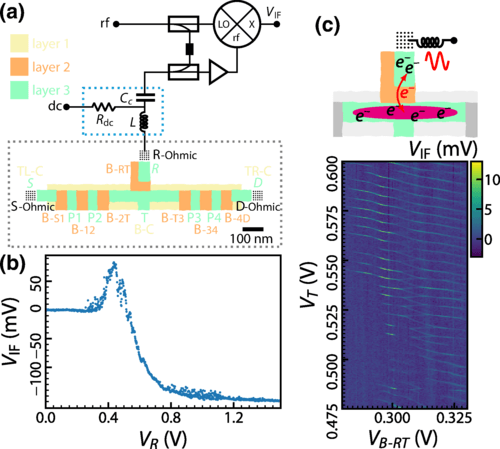Researchers from Quantum Motion, the London Centre for Nanotechnology at University College London, the Center for Quantum Devices at the Niels Bohr Institute, and imec have used elongated quantum dots in a MOS device to extend the range of spin-spin interactions. This could potentially enable compact quantum processor layouts and more efficient quantum computers. The team operated the dot as a single-electron box to achieve charge sensing of remote quantum dots, demonstrating that charge states are well distributed across its length. The research could have applications in various fields, including telecommunications, electronics, and healthcare.
What are Elongated Quantum Dots and Why are They Important?
Elongated quantum dots are a type of semiconductor quantum dot that have been utilized in GaAs heterostructures to extend the range of spin-spin interactions. These quantum dots are important because they offer scaling advantages by facilitating gate routing and the integration of sensors and charge reservoirs. This is particularly useful in the field of quantum computing, where the ability to scale up and integrate various components is crucial for the development of more powerful and efficient quantum computers.
In a recent study conducted by a team of researchers from Quantum Motion, the London Centre for Nanotechnology at University College London, the Center for Quantum Devices at the Niels Bohr Institute, and imec, an elongated quantum dot was used in a MOS device where two quantum dot arrays were separated by the elongated quantum dot. The elongated quantum dot was 340 nm long and 50 nm wide. The researchers were able to monitor charge transitions of the elongated quantum dot by measuring radiofrequency single-electron currents to a reservoir to which they connected a lumped-element resonator.
The researchers operated the dot as a single-electron box to achieve charge sensing of remote quantum dots in each array separated by an edge-to-edge distance of 480 nm. This demonstrated that the charge states are well distributed across its nominal length, which was supported by the simulated quantum mechanical electron density.
How Does This Research Contribute to Quantum Computing?
Quantum computing is a rapidly evolving field that relies heavily on advancements in quantum mechanics and nanotechnology. Silicon spin qubits hosted in gate-defined quantum dots have achieved major milestones, making this platform a compelling option for large-scale quantum computing. These milestones include the demonstration of high-fidelity one and two-qubit gates on the same device, high-fidelity readout using rf single-electron transistors, the demonstration of simple instances of quantum error correction, and the scale up to six qubit devices in a linear array.
The research conducted by the team from Quantum Motion, the London Centre for Nanotechnology at University College London, the Center for Quantum Devices at the Niels Bohr Institute, and imec contributes to this field by demonstrating how single-electron boxes can be realized with versatile footprints. This could potentially enable compact quantum processor layouts offering distributed charge sensing in addition to the possibility of mediated coupling.
The researchers also showed that elongated peripheral quantum dot tunnel couplings can exceed 20 GHz above the electron temperature, fulfilling the requirement for mediated exchange. This is a significant finding as it could potentially lead to the development of more efficient and powerful quantum computers.
What are the Potential Applications of This Research?
The potential applications of this research are vast and could have a significant impact on the field of quantum computing. The ability to create single-electron boxes with versatile footprints could enable the development of compact quantum processor layouts. This would not only make quantum computers more efficient but could also potentially make them more accessible and affordable.
Furthermore, the ability to achieve charge sensing of remote quantum dots could potentially lead to the development of more advanced sensors and charge reservoirs. This could have applications in a variety of fields, including telecommunications, electronics, and healthcare.
Finally, the ability to exceed 20 GHz above the electron temperature in elongated peripheral quantum dot tunnel couplings could potentially lead to the development of faster and more powerful quantum computers. This could revolutionize the field of quantum computing and could have a significant impact on a variety of industries, including finance, healthcare, and cybersecurity.
What are the Next Steps in This Research?
The research conducted by the team from Quantum Motion, the London Centre for Nanotechnology at University College London, the Center for Quantum Devices at the Niels Bohr Institute, and imec is a significant step forward in the field of quantum computing. However, there is still much work to be done.
The next steps in this research could potentially involve further exploring the potential applications of this technology. This could involve developing more advanced sensors and charge reservoirs, as well as exploring the potential for creating more efficient and powerful quantum computers.
Furthermore, the researchers could potentially explore the possibility of scaling up this technology. This could involve creating larger arrays of quantum dots and exploring the potential for integrating these arrays into existing quantum computing platforms.
Finally, the researchers could potentially explore the possibility of commercializing this technology. This could involve partnering with technology companies or startups to bring this technology to market. This could potentially lead to the development of more affordable and accessible quantum computers, which could have a significant impact on a variety of industries.
Publication details: “Elongated quantum dot as a distributed charge sensor”
Publication Date: 2024-05-22
Authors: S. M. Patomäki, J. Williams, Fabrizio Berritta, C. Lainé, et al.
Source: Physical review applied
DOI: https://doi.org/10.1103/physrevapplied.21.054042

